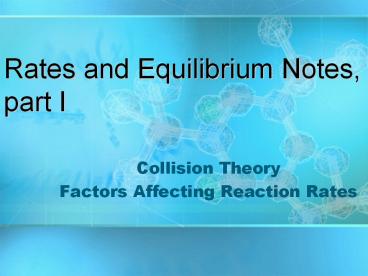Rates and Equilibrium Notes, part I - PowerPoint PPT Presentation
1 / 18
Title:
Rates and Equilibrium Notes, part I
Description:
Rates and Equilibrium Notes, part I Collision Theory Factors Affecting Reaction Rates Reaction Rates We have talked about many reactions so far, but we have not ... – PowerPoint PPT presentation
Number of Views:112
Avg rating:3.0/5.0
Title: Rates and Equilibrium Notes, part I
1
Rates and Equilibrium Notes, part I
- Collision Theory
- Factors Affecting Reaction Rates
2
Reaction Rates
- We have talked about many reactions so far, but
we have not talked about how fast a reaction
occurs. - A reactions rate is the speed at which it will
occur.
3
Collision Theory
- Reactions occur when atoms, ions or molecules
collide, providing that they have enough energy
to do so. - Why only if they have enough energy?
4
Activation Energy
- Activation energy is the minimum amount of energy
particles need to react with each other.
5
Orientation
- Atoms also have to collide in the right
configuration to react.
6
Reaction Mechanisms
- Because molecules have to collide to react, large
reactions with lots of reactants do not happen at
once. - A reaction mechanism is the series of steps that
take place. - See board for example and graph.
7
(No Transcript)
8
Factors Affecting Reaction Rates
- Every reaction proceeds at its own rate, but by
modifying the conditions a reaction takes place
in, we can change the speed reactions occur.
9
1) Temperature
- Usually, raising the temperature of a reaction
speeds up a reaction (the opposite is true, as
welllowering temperature slows down reaction). - Why?
10
1) Temperature
- As the temperature of particles increases, their
overall energy increases (increasing the chance
that there will be enough energy for the
reaction). Also, the faster moving particles are
more likely to collide.
11
2) Concentration
- Generally, increasing concentration of reactants
increases a reactions rate. - Why?
No, not THAT kind of concentration!
12
2) Concentration
- Because you have more particles in the same
amount of space (the same volume) there are more
collisions, thus more chances each second for the
reaction to occur!
13
3) Particle size
- Decreasing the particle size for the same amount
of reactant will cause the reaction rate to
increase. - Why?
14
3) Particle size
- Decreasing particle size increases the total
amount of reactant exposed for reaction. The
more exposure, the more likely that collisions
will occur and thus, a faster reaction!
15
3) Particle size
- Surface area is the same idea, but looked at in
the opposite way. - The smaller particle size for the same amount of
stuff, the higher the surface areaso the higher
the surface area, the faster the reaction.
16
4) Catalysts
- A catalyst is something that speeds up a reaction
without being used up. - How does it work?
17
4) Catalysts
- Catalysts allow a reaction to proceed at a lower
than normal activation energy. - It can do this by forming an alternate route
for the reaction to occur, sometimes allowing for
an intermediary product.
18
4) Catalysts
- Other catalyst terms
- An inhibitor is a substance that acts against the
effects of a catalyst. - An enzyme is specifically a biological catalyst
usually composed of a protein.































